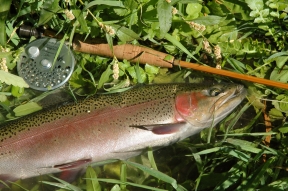

I focused on the 2016 season on the Ranch in my last blog. Mostly I regurgitated a lot of data that was provided to me by the Henry’s Fork Foundation. I based my conclusions on the data I received. The final result was the longest blog I’ve ever written. To sum things up I felt like the fishing on the Ranch in 2016 was tough but I’ve seen it a lot worse. Based on all of the scientific data I was provided and my own observations as an outfitter, the damage to the Ranch fishery was minimal and disaster was avoided due to some very resourceful and vigilant action by the Henry’s Fork Foundation.
Whether we like it or not, the single greatest influence on our fishery, especially Box Canyon and the Ranch, is weather. There is a lot of data available that dates back 80 years. Essentially we’ve come from a very dry period back in the 1930s to another dry period now. Streamflows in the upper Henry’s Fork watershed over the water years 2014 – 2016 show a cumulative deficit not seen since the late 1930s. Late winter temperatures, critical for timing of our runoff, are a full 6°F warmer than they were in 1976, the year we started in business. The result is that even during years when our snowpack has been at or above normal, when our runoff peaks due to warm weather melting the snow earlier than normal, the effects are felt throughout the remainder of the season.
Hatches, spring spawning, growth of aquatic vegetation (macrophytes) and many other ecological processes are driven by temperature and peak runoff timing. Low water supply from major tributaries like the Fall and Teton Rivers earlier than the long term average are the main triggers for delivery of storage water from Island Park Reservoir.
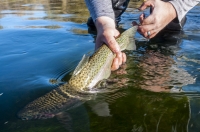
Many people praised the Henry’s Fork Foundation for the quality of fishing on the Ranch from 2013 – 2015, yet some of these same people turned on the HFF after the 2016 season. The great fishing resulted mostly from a minimum winter flow of more than 600 cfs during the winter of 2011 resulting in several years of great fishing. The Foundation did not take the credit for that and they shouldn’t take the blame for what happened in 2016. Mother Nature deals these cards. I strongly recommend you read the latest blog by Dr. Rob Van Kirk on the Henry’s Fork Foundation website for more detailed information on the weather patterns and its relationship to the Henry’s Fork fishery.
It is unreasonable for anyone to demand the HFF do something about the fishing when our snowpack is down or our runoff comes 3 weeks early. The HFF is doing a lot and they have accomplished a lot but they cannot control the weather. I wrote about this in my blog of May 2016 entitled “The New Normal.”

It is important to understand that hatches, water flows and other factors that have the greatest influence on our fishing may not follow traditional patterns. As often as not the Green Drake hatch will occur before the Ranch opens on June 15th. Other early season hatches including caddisflies, Pale Morning Duns and March Browns may start showing up at least 3 weeks ahead of schedule. When this happens it often leaves a lag later in the season after these hatches are over. I can’t help but suspect that the growth of cyanobacteria (blue green algae) is nurtured when the reservoir is lower during the heat of the summer causing water clarity issues in the Box Canyon and the Ranch.
Rather than expect the Henry’s Fork Foundation to do the impossible and control the weather, individually you might consider adjusting your traditional routines. For example, in the past our focus for the salmonfly hatch was the Memorial Day weekend. Nowadays, if you wait until then the hatch might be all the way up the river into the Box Canyon or you might miss it entirely. If you want to hit the salmonfly hatch on the Lower Henry’s Fork followed by the Golden Stones you need to be here before the 20th of May. In a warm year with early runoff, it is completely unreasonable to expect to find the same fishing conditions on June 15 that existed over the long term. It could be possible to adjust the season opener on the Harriman Park section earlier than the traditional June 15th. The Ranch always closed on September 30th and was later amended to close on November 30th. It seems logical that the opening date could also be adjusted.
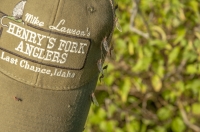
Another problem that occurs as a result of losing our runoff early is the impact it has on fishing later in the summer. We’ve already discussed water clarity resulting from cyanobacteria flushed through the dam. What impact does early runoff have on aquatic insects? Science tells us that the Henry’s Fork remains one of the most prolific trout rivers in the world. Read Dr. Rob Van Kirk’s blog of October 17 on the Henry’s Fork Foundation website.
When I was writing my book Spring Creeks I often consulted with Dr. George Edmunds at the University of Utah. I quickly learned that personal observation is the least effective method of determining macroinvertebrate populations. Macroinvertebrates are not only comprised of aquatic insects like midges, mayflies, caddisflies and stoneflies but also leeches, worms, mollusks, crustaceans and other non-insects. Aquatic insects spend their entire lives as nymphs or larvae and only emerge for a very brief period to mate. I also realized that when the emergence period for some species like our Pale Morning Duns is earlier than normal, mostly due to the influence of water temperature, the hatches won’t be as concentrated. There are only X number of specific aquatic insect species that occupy a given square meter of stream bottom. If these species emerge 3 weeks earlier than normal, it is illogical to expect them to continue to emerge later in the season. This phenomena knocks a void later in the season because the bugs that normally emerge then are gone.
It is irresponsible to fish the Ranch later in the season and expect to find fish feeding on the same Pale Morning Duns that began their emergence three weeks early. Under these conditions you might need to adjust your program. As we found last season, it was still possible to catch good fish blindly fishing hoppers and other terrestrials.
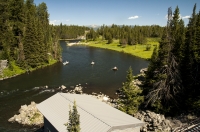
If we’re to be left to the whims of Mother Nature, why do we need the Henry’s Fork Foundation? From its organization in 1984 there has never been a time we’ve needed them more. Currently we know more about this river than any other great trout stream in the country due to our ongoing research effort. Refer to my last blog about what we know to find out more. Our relationship with the Fremont Madison Irrigation District has never been better. The development of the Henry’s Fork Watershed Council brings all stake holders together every month to discuss all of the issues with regard to our river. The Drought Management Plan gives the Henry’s Fork Foundation a seat at the table in order to make critical decisions. This relationship kept more than 20,000 acre feet in the reservoir at the end of the last irrigation season, at least 10,000 acre feet more than predicted which avoided a serious sediment flush. It also resulted in an average winter outflow of 165 cfs, less than ideal, but more than double the paltry projections based on conditions last August.
One of our first projects when we started the Foundation was to fence the river in the Harriman State Park to keep the cattle from wrecking the banks. Fencing has always been an ongoing effort. Last year nearly 30 volunteers put up 6 miles of new fence. Another success has been the Buffalo River Fish Ladder. This project has improved spawning and provided habitat for juvenile trout for the past 10 years.
One of the key elements to meet the challenge of maintaining the water quality in the Box Canyon and the Ranch is the Island Park Reservoir. The HFF is committed to exploring the feasibility of development of infrastructure at the reservoir to improve water quality. A new sewage treatment system for Bills Island, and homes around the Lakeside/Shotgun area would reduce phosphorus input. Phosphorus is the key ingredient that fosters the growth of the troublesome cyanobacteria. Another consideration is to build a new outlet structure at the dam that can draw water from different levels (not just from the bottom) which could greatly improve water clarity and reduce export of sediment downstream. These ideas are huge and far beyond anything that the Foundation has considered in the past. The cost would be very high but they are very noteworthy considerations.
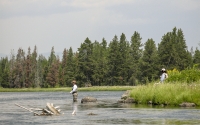
These ideas and others won’t get to first base without solid water quality data. Currently the HFF research team headed by Dr. Rob Van Kirk has four instruments that allow them to quantify the effect of all aspects of I P Reservoir management on water quality. These are located at Flatrock (upstream control), I P Dam West (river right, at the dam gates), I P Dam East (river left, at the power-plant compliance point) and Buffalo River (allows calculation of actual conditions in the river in the Box Canyon). These instruments record temperature, dissolved oxygen, chlorophyll, cyanobacteria, river depth, turbidity, (suspended sediment can be calculated from this) and conductivity every 15 minutes. In addition they measure phosphorus, nitrogen, suspended sediment, and organic fraction of suspended sediment in water samples taken every week or two. They also record all of these parameters (instrumented and water samples) in the reservoir itself at all depths, at the dam gates and the power plant intake once a week.
These instruments have already paid great dividends. The instrument downstream of the dam in 2014 recorded that the power plant was in violation of its dissolved oxygen standard and had been doing so for 5 years. Because of this data Fall River Electric was forced to repair and run their aerators and they are now back in compliance. In addition, real-time data from these instruments led to identification of operations at the hydro plant that violated their flow ramping rate. After a letter to FERC from the HFF, the operator completely updated their control system.
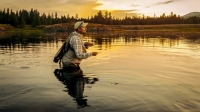
The Henry’s Fork Foundation has gone from no program in 2013 to the most extensive monitoring program anyone has anywhere in the state. These relationships are quantitative and causative – not anecdotal observations. It’s hard to describe how excited I am about this. We can know exactly what is going on with water quality in the both the reservoir and the river that can’t be questioned. The water quality program will help improve fishing conditions and habitat – not just put more water in the river in the winter for juvenile trout survival.
In the long run, the monitoring will allow the HFF to quantify success which could enable leasing water that will stay in the reservoir all summer. In the fall of 2015, a landmark settlement to a decade-long water-rights court case opened up a new market for exchanging water between surface water users and groundwater users. This development has great potential to help with winter flows but it has to be carefully studied. The HFF has to simultaneously prevent water markets from causing harm while also developing programs that will provide a net benefit to the Henry’s Fork.
I’m cautiously more optimistic than I was at this time last year for our water prospects this summer. Our snowpack was well above normal as little as a week ago but as in the past, our March weather has been warmer than normal and we’ve started losing ground fast. For the short term it’s too early to predict what our summer will be like. Long term, I strongly believe that the data from the water quality instruments, the relationships with the community, irrigators, and other stake holders will provide a significant opportunity to help meet the challenges we face in the years ahead.